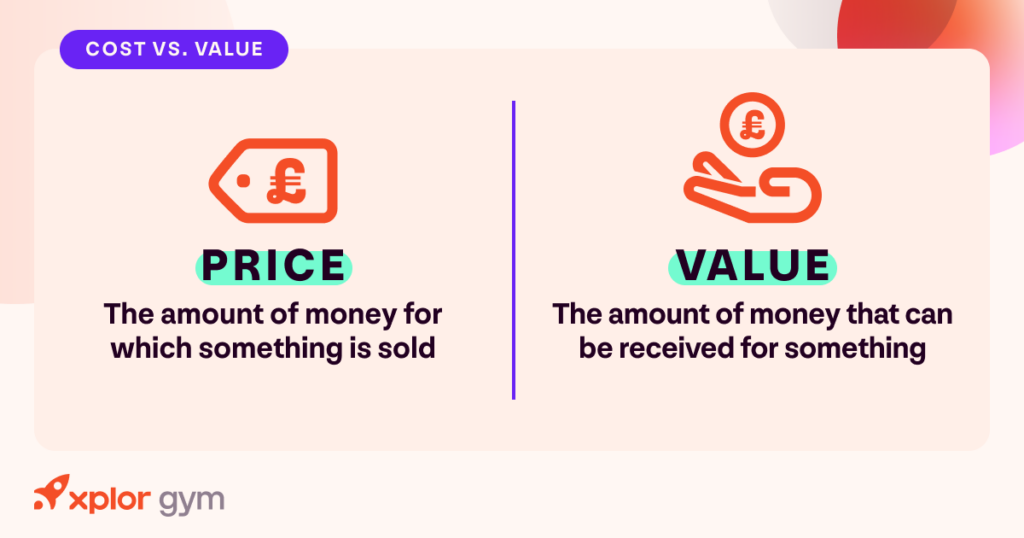All too often, gyms and fitness clubs become stuck competing on price. Shifting to selling on value can help you charge what you deserve for memberships. Learn more and find out how to take the leap and start charging on value.
The famous Warren Buffett quote goes: “Price is what you pay, value is what you get.” Often, people (and especially those who’ve never had a gym membership) judge gyms purely on price.
And that’s especially true given the accelerated growth of low cost gyms in the UK over the last decade or so.
People have become used to membership prices being low. And, while average gym membership prices at privately-owned gyms have increased from £42.99 in 2022 to £47.24 in 2024, the impact of low prices lingers on.
For many, a gym membership is a cost to be paid for a commodity, rather than an investment that’ll pay off in time. How can you help your target audience to shift their mindset and really see the value of being a member of your gym?
Let’s get stuck in!
Insights & strategies to increase sales
The Gym Membership Sales Report features exclusive insights from across the UK fitness industry. Plus, expert tips and tricks to help you maximise sales and minimise attrition.
A membership is an investment choice
Cost of living is still a concern for many people. A recent survey for the Office of National Statistics found that 89% of people in Great Britain believed cost of living is an important issue.
Cost is a reason for quitting
The impact of stretched household budgets can be seen in the reasons why members quit the gym.
ukactive’s Consumer Engagement research found that on average across quarterly polling from September 2022-April 2024:
- 26% of former gym members cancelled as it was too expensive
- And 12% could no longer afford their membership due to the rising cost of living
Cost is a barrier to joining
Concern over cost and perceived value for money are also key reasons why many prospective gym members choose not to invest in a membership.
ukactive’s research also asked people who aren’t currently or have never been a gym member what’s holding them back from becoming a member. 68% of respondents said cost was the biggest barrier to joining a gym.
Likewise, a June 2024 Active Insight consumer poll found that over 50% of respondents had been put off signing up for a gym membership due to cost and perceived value for money.

The benefits of selling on value over price
Concern over cost and price is a barrier to joining a gym and a reason to quit.
You could try to get around it by lowering prices to attract and keep more members. Yet, in doing so, you’ll cut your profit margins. And become reliant on signing up more new members to chase growth.
Overcoming cost as a barrier, and being able to charge what you deserve, is essential to boosting profitability and building a thriving business.
And to do this you need to convince prospects and members that a membership is a long term investment worth making.

That means you need to sell the value you provide to members. To do this you need to:
- Know what members really value
- Satisfy and exceed member expectations
- And, ultimately, offer something they can’t get elsewhere
Value-based pricing
TipValue-based pricing is based on a consumer’s perceived value of a product/service. It’s a customer focused approach to pricing based on how much they believe an offering is worth.
Learn more about pricing strategies
Perceived value for money
‘Value for money’ means different things for different people. Generally, when it comes to perceived value for money, people judge gym and fitness club memberships based on a combination of:
- The amount paid compared to the amount of service they get (for example, cost per use)
- The ‘products’ included (classes, inductions, PT-led sessions etc.)
- The environment of a facility (changing rooms, gym floor, wellness facilities, studios, car park, etc.)
Retention Guru research found that the exact combination that constitutes value for money differs based on experience level:
- Those who’ve never been a gym member are more likely to judge on cost per use – and can have unrealistic expectations of how often they’ll visit. They’re also influenced by the look of a club
- Experienced members know specifically what they want and measure value against this
Effectively selling on value means you need to understand and tap into what each individual wants based on their experience level and preferences.

Tap into the true motivations of your target audience
Having a clearly defined and well-researched target audience can help you understand what they’re looking for in a fitness club. And knowing what their true motivations in joining (and sticking with) a gym can help you emphasise the right things.
Go deeper
Learn more about what motivates UK gymgoers to buy memberships and visit gyms.
Get the Gym Membership Sales ReportFor example, that might mean emphasising:
- How your team goes the extra mile to support and motivate them towards their goals
- The opportunity to be part of your thriving community
- Ways you can help them manage, overcome, and prevent health problems and chronic diseases
- The mental health benefits exercise offers
- How keeping physically fit can improve quality of life for the long-term
“Our Consumer Engagement research highlights that motivations, such as mental health benefits, resonate with consumers.
To continue to drive value from these motivations, storytelling can be invaluable. Demonstrating community through real stories and relatable people can be just the ‘ticket’ to retaining and engaging new people.”
Hattie Jones, ukactive
People will pay more for something they feel they get exceptional value from. High quality, clean facilities and an efficient experience are a must.
And to succeed with value-based pricing and selling, you need to focus on member satisfaction. Satisfied, happy members will stick with you and talk positively about your business.

Offer something genuinely different
If you want to sell on value rather than price, you need to stand out from your competition. Prospects and members must believe that you can offer them something unique and valuable that they can’t get from another gym.
When selling, focus on educating prospective members. Understand what they’re really looking for and their motivations for joining a gym like yours. Provide compelling content to show:
- How you can help solve their problems
- And how enjoyable their experience will be
The power of your team
Your gym staff can be a powerful resource to help you offer something genuinely different.
Research shows that member-staff interaction has the biggest impact on perceived value when:
- It’s personal
- And helps the member on their way to achieving goals
The research also shows that some interactions have more impact than others. Interactions while they are physically active have a high perceived value.
Make sure all members feel valued and staff understand the importance of everyday interactions in helping members feel part of your gym community.

Recognise that price is still important
Price will always be important to some prospects and members when weighing up their fitness options. So, if you want to charge a higher price, you need to make sure you back up prices with real value and a satisfying member experience.
When introducing value-based pricing, or simply increasing your prices to better cover operating costs, make sure you’re able to communicate the value you provide clearly. Let members know about the increase well in advance of the change happening and talk about the value you offer.
David Lloyd Leisure example
Premium health and fitness club operator, David Lloyd Leisure has been strategically upgrading its clubs over the last couple of years.
To tap into the premium health and wellbeing market, David Lloyd has added state-of-the-art spa retreats into some existing clubs. And the operator has added outdoor dining areas and co-working areas, encouraging members to spend more time at the clubs.
At the same time, in late-2022/early-2023, the operator introduced a price increase, highlighting the improvements and the value that a membership for its clubs holds.
This strategic focus on a specific market segment and selling on value has paid off. In the year to end-December 2023, the operator reported a 3.5% increase in members. And over 61% of those members were signed up to a premium membership.
New joiners particularly favoured these premium packages with 81% of new members signing up to a ‘platinum’ or ‘diamond’ membership over a basic plan.
As a result, David Lloyd Leisure increased its membership base and increased average spend per customer. And so, boosted revenue by £101m for 2023.
The wrap up…
When choosing whether or not to join a gym, and picking a specific club, price can play a significant deciding role. Often, gym memberships are viewed as a commodity, rather than an investment that will pay off in time.
Cost and lack of perceived value is also a reason why many members choose to cancel.
It’s easy to overcome objections to cost by lowering prices. But, this can negatively impact your ability to run a profitable fitness business. To charge what you deserve and build a thriving business, selling on value is a must.
To take a value-based approach to pricing, you need to understand what your target audience perceives as value for money. And what really motivates them to be a part of your gym. Plus, it means providing a satisfying experience that they can only get from your fitness club.
You need to communicate your value really clearly and convincingly. And tap into what value for money means for different groups within your target audience.
The right gym management software can help you deliver the type of member experience that exceeds expectations. Software like Xplor Gym. Request a demo to see for yourself.
Power up your business & stay in the know

by Megan Greenaway Customer Success Manager at Xplor Gym
-
First published: 30 September 2024
Written by: Megan Greenaway
